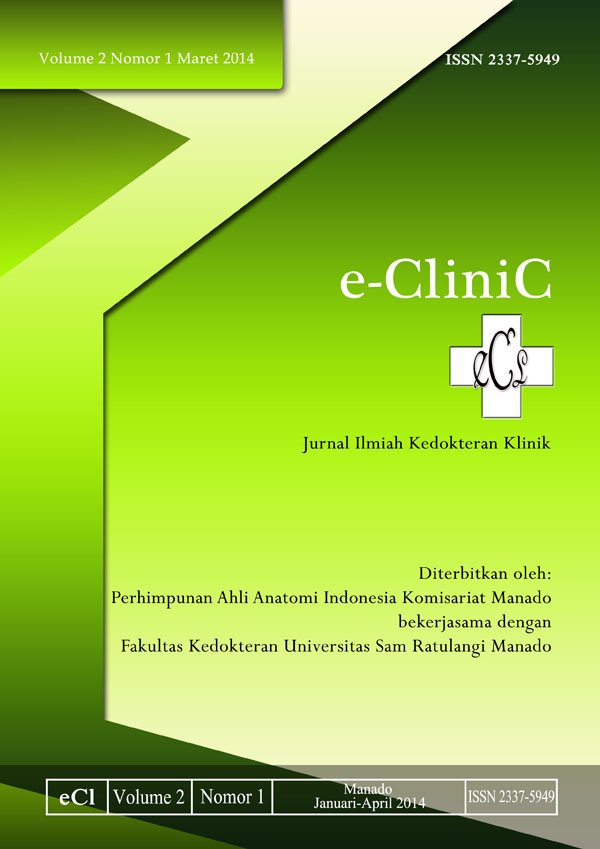KESEHATAN TENGGOROK PADA SISWA SEKOLAH DASAR EBEN HAEZAR 1 MANADO DAN SEKOLAH DASAR GMIM BITUNG AMURANG KABUPATEN MINAHASA SELATAN
DOI:
https://doi.org/10.35790/ecl.v2i1.3669Abstract
Abstract: Background: Upper respiratory tract infections include pharyngitis and tonsillitis. The highest prevalence of chronic tonsillitis after acute nasopharyngitis is equal to 3.8 %. In Indonesia, incidence of acute pharyngitis is approximately 1.5 % that include in the top 10 of outpatient cases. Aim: To obtain data of throat health in Eben Haezar 1 Elementary Student Manado and GMIM Bitung Amurang Elementary Student of South Minahasa Regency. Methods: This is a descriptive observational study to obtain data of throat health in 5th C grade student in Eben Haezar 1 Elementary School Manado and entire of 5th grade student in GMIM Bitung Amurang Elementary School of South Minahasa Regency. Results: Total of 5th grade student in Eben Haezar 1 Elementary School Manado were  31 students. There was not found student with grade 4 of tonsil enlargement. The result showed that 29 students (93.5%) with smooth surface of the tonsil and 2 students (6.6%) with rough surface of the tonsil. No abnormality found in pharynx surface. Total of 5th grade student in GMIM Bitung Amurang Elementary School were 18 students. There was found one student with grade 4 of the tonsil enlargement. The result showed that 14 students (77.8%) with smooth surface of the tonsil and 4 students (22.2%) with rough surface of the tonsil. Pharyngeal examination showed that 5 students (27.8%) with granules and 13 students (72,2%) with normal appearance. Conclusion: Disorders of throat are higher in GMIM Bitung Amurang Elementary School than Eben Haezar 1 Manado Elementary School.
Key words: Throat, Elementary School Students, Pharynx Examination, Tonsil Examination.
Â
Â
Abstrak: Latar Belakang: Infeksi saluran nafas atas termasuk faringitis dan tonsillitis. Prevalensi tertinggi tonsillitis kronik setelah nasofaringitis akut yaitu sebesar 3,8 %. Di Indonesia dilaporkan bahwa kasus faringitis akut masuk dalam 10 besar kasus penyakit yang dirawat jalan dengan presentase jumlah penderita 1,5 %. Tujuan: Memperoleh status kesehatan tenggorok pada siswa SD Eben Haezar 1 Manado dan siswa SD GMIM Bitung Amurang Kabupaten Minahasa Selatan. Metode: Penelitian ini menggunakan metode deskriptif observasional secara cross sectional untuk mendapatkan status kesehatan tenggorok pada seluruh siswa kelas 5c SD Eben Haezar 1 Manado dan seluruh siswa kelas 5 SD GMIM Bitung Amurang Kabupaten Minahasa Selatan. Hasil: Jumlah siswa kelas 5c di SD Eben Haezar 1 Manado berjumlah 31 orang. Pada pemeriksaan ukuran tonsil tidak didapatkan ada anak yang memiliki ukuran tonsil T4. Pemeriksaan berdasarkan permukaan tonsil, 29 siswa (93,5%) memiliki tonsil licin dan 2 orang (6,6%) memiliki tonsil kasar. hasil pemeriksaan berdasarkan gambaran faring, didapatkan semuanya normal. jumlah siswa kelas 5 di SD GMIM Bitung Amurang berjumlah 18 orang. hasil pemeriksaan ukuran tonsil didapatkan ada 1 orang siswa yang memiliki ukuran tonsil T4. Pemeriksaan berdasarkan permukaan tonsil, 14 siswa (77,8%) memiliki tonsil licin dan 4 orang (22,2%) memiliki tonsil kasar. hasil pemeriksaan berdasarkan gambaran faring, didapatkan 5 orang iswa (27,8%) yang faringnya terdapat granula dan 13 siswa lain gambaran faringnya, normal (72,2%). Kesimpulan: Temuan kelainan terkait kesehatan tenggorok lebih banyak terdapat di SD GMIM Bitung Amurang.
Kata Kunci: Tenggorok, Siswa Sekolah Dasar, Pemeriksaan Faring, Pemeriksaan Tonsil
Downloads
How to Cite
Issue
Section
License
COPYRIGHT
Authors who publish with this journal agree to the following terms:
Authors hold their copyright and grant this journal the privilege of first publication, with the work simultaneously licensed under a Creative Commons Attribution License that permits others to impart the work with an acknowledgment of the work's origin and initial publication by this journal.
Authors can enter into separate or additional contractual arrangements for the non-exclusive distribution of the journal's published version of the work (for example, post it to an institutional repository or publish it in a book), with an acknowledgment of its underlying publication in this journal.
Authors are permitted and encouraged to post their work online (for example, in institutional repositories or on their website) as it can lead to productive exchanges, as well as earlier and greater citation of the published work (See The Effect of Open Access).







